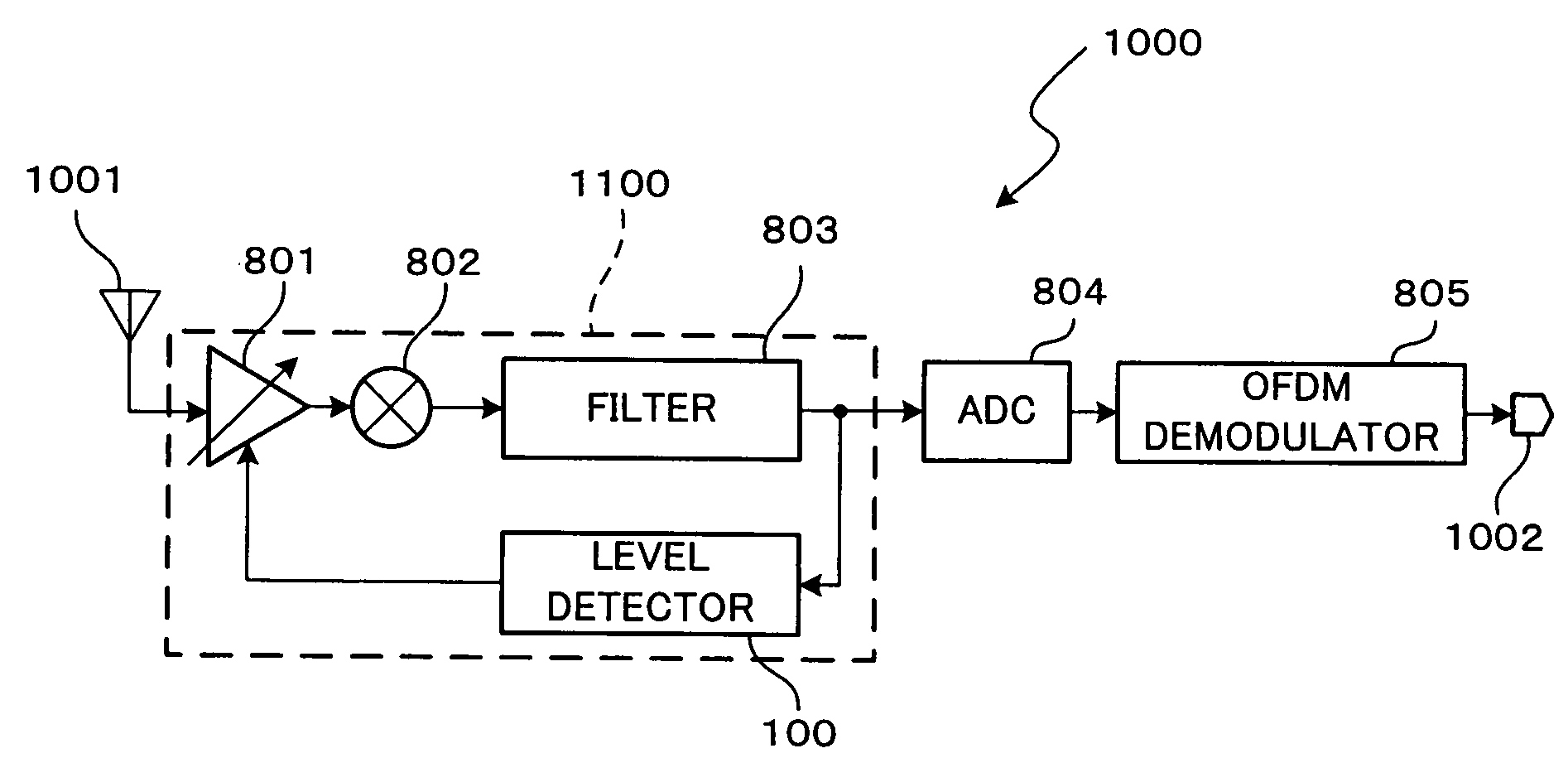Level detector, communication apparatus, and tuner
a level detector and communication apparatus technology, applied in the field of level detectors, can solve the problems of not being able to distinguish the waveform from another low-strength waveform, unable to remove the high-strength component that rarely appears, and unable to achieve waveforms in which the strength fluctuates extremely sharply, so as to reduce the variation generated, reduce the variation in the width of the pulse output, and reduce the variation
- Summary
- Abstract
- Description
- Claims
- Application Information
AI Technical Summary
Benefits of technology
Problems solved by technology
Method used
Image
Examples
first embodiment
[0037]The receiver 1000 includes an antenna unit 1001, a tuner unit 1100, an analog-to-digital converter (ADC) circuit 804, and an OFDM demodulator 805. An OFDM-modulated signal is input to the tuner unit 1100 through the antenna unit 1001. The tuner unit 1100 applies a channel selecting process to the OFDM-modulated signal. The channel-selecting-processed signal is input to the ADC circuit 804. The ADC circuit 804 converts the channel-selecting-processed signal from an analogue signal into a digital signal. The converted digital signal is input to the OFDM demodulator 805. The OFDM demodulator 805 demodulates the digital signal into a data string signal. The demodulated data string signal is output through an output terminal 1002 to the exterior of the receiver 1000.
[0038]The tuner unit 1100 includes therein a variable gain amplifier (VGA) 801, a mixer circuit 802, a filter circuit 803, and a level detector 100. The received signal sent from the antenna unit 1001 is amplified by th...
second embodiment
[0073]Next, a second embodiment of the present invention will be described with reference to FIG. 6. FIG. 6 is a circuit diagram showing a construction of a pulse width extending circuit 320 according to the second embodiment. In the second embodiment, the pulse width extending circuit 120 of the first embodiment is replaced by the pulse width extending circuit 320. The description of the parts other than the parts different from the first embodiment will be arbitrarily omitted below. The same components as in the first embodiment are denoted by the same references as in the first embodiment, respectively.
[0074]The pulse width extending circuit 320 includes therein a diode D2, a capacitor C2, a resistor R2, and a comparator CMP2. The anode of the diode D2 is connected to the output terminal of the comparing circuit 110 through an input terminal 321. Either of one ends of the capacitor C2 and the resistor R2 is connected to the cathode of the diode D2. Either of the other ends of the...
third embodiment
[0082]Next, a third embodiment of the present invention will be described with reference to FIG. 7. FIG. 7 is a circuit diagram showing a construction of a comparing circuit 410 according to the third embodiment. In the third embodiment, the comparing circuit 110 of the first embodiment is replaced by the comparing circuit 410. The description of the parts other than the parts different from the first embodiment will be arbitrarily omitted below. The same components as in the first embodiment are denoted by the same references as in the first embodiment, respectively.
[0083]An OFDM signal is input to the comparing circuit 410 from the filter circuit 803 through an input terminal 411. The comparing circuit 410 includes therein comparators CMP1 and CMP11; DC power supplies E1 and E11; and an OR circuit OR1. The non-inverting input of the comparator CMP1 and the inverting input of the comparator CMP11 are connected to the input terminal 411. The inverting input of the comparator CMP1 is...
PUM
 Login to View More
Login to View More Abstract
Description
Claims
Application Information
 Login to View More
Login to View More - R&D
- Intellectual Property
- Life Sciences
- Materials
- Tech Scout
- Unparalleled Data Quality
- Higher Quality Content
- 60% Fewer Hallucinations
Browse by: Latest US Patents, China's latest patents, Technical Efficacy Thesaurus, Application Domain, Technology Topic, Popular Technical Reports.
© 2025 PatSnap. All rights reserved.Legal|Privacy policy|Modern Slavery Act Transparency Statement|Sitemap|About US| Contact US: help@patsnap.com



